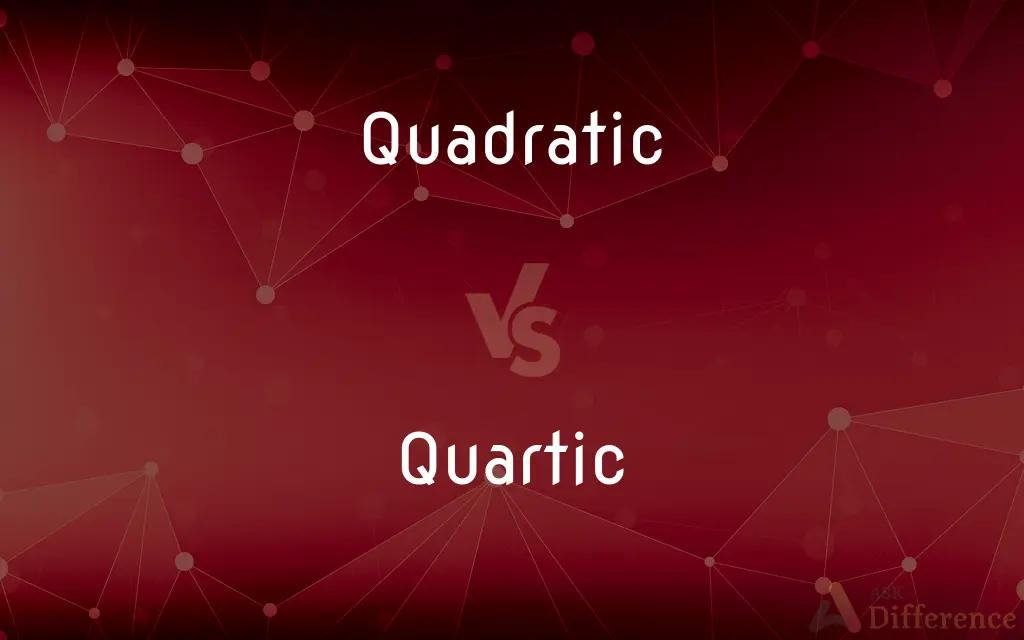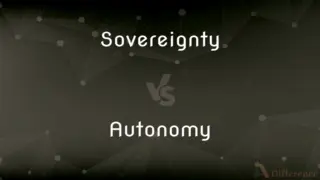Quadratic vs. Quartic — What's the Difference?
Edited by Tayyaba Rehman — By Fiza Rafique — Updated on March 29, 2024
Quadratic equations involve terms up to the second degree, while quartic equations include terms up to the fourth degree, indicating more complexity.

Difference Between Quadratic and Quartic
Table of Contents
ADVERTISEMENT
Key Differences
Quadratic equations, characterized by the highest exponent of 2, are fundamental in algebra, describing parabolic shapes when graphed. Whereas quartic equations, which go up to the fourth degree describe more complex curves and are significant in fields requiring higher precision.
The solutions to a quadratic equation can always be found through the quadratic formula, guaranteeing up to two real roots depending on the discriminant. On the other hand, finding the roots of a quartic equation involves more complex formulas, capable of yielding up to four real roots, and the process is significantly more intricate than for quadratic equations.
Quadratic equations often emerge in problems involving areas, projectile motion, and simple optimization issues, where the relationship between variables can be represented by a parabola. Quartic equations, however, find applications in more complex scenarios, including certain types of optimization problems, the study of light, and in theories explaining natural phenomena that involve higher degrees of interaction.
In terms of graphical representation, the graph of a quadratic equation is always a parabola, which may open upwards or downwards depending on the sign of a. In contrast, the graph of a quartic equation can exhibit various shapes, including having up to four x-intercepts and multiple turning points, reflecting its higher degree of complexity.
The study of quadratic equations is foundational in mathematics, offering insights into basic algebraic properties and the behavior of polynomial equations. Meanwhile, quartic equations push these boundaries further, challenging mathematicians and scientists to apply more advanced techniques for their resolution and interpretation.
ADVERTISEMENT
Comparison Chart
Solutions
Up to 2 real roots.
Up to 4 real roots.
Graph Shape
Parabola.
Can vary widely, including shapes with up to four x-intercepts and multiple turning points.
Common Applications
Areas, projectile motion, simple optimization problems.
More complex optimization problems, theories in physics and engineering.
Degree of Equation
Second degree
Fourth degree
Formula for Solutions
Quadratic formula
Complex formulas involving radicals and possibly requiring numerical methods for solutions.
Compare with Definitions
Quadratic
A quadratic equation is a second-degree polynomial equation of the f.
The quadratic equation can be solved to find its roots.
Quartic
Solving quartic equations can involve complex formulas or numerical methods, unlike the straightforward quadratic formula.
Finding the exact roots of a quartic equation often requires advanced algebraic techniques.
Quadratic
Quadratic equations often model phenomena with a single peak or trough, such as projectile motion.
The maximum height of a projectile can be determined by solving a quadratic equation.
Quartic
They push the understanding of polynomial behavior, requiring more advanced mathematical knowledge.
Studying quartic equations introduces students to complex algebraic and numerical methods.
Quadratic
They are fundamental in algebra, introducing the concept of polynomial equations and their properties.
Understanding quadratic equations is crucial for advancing in algebra and calculus.
Quartic
Quartic equations are used in various complex mathematical and physical problems, including optimization and light theory.
Certain physics problems involving light reflection and refraction can be modeled by quartic equations.
Quadratic
Of, relating to, or containing quantities of the second degree.
Quartic
Of or relating to the fourth degree.
Quadratic
Square-shaped
Quartic
(mathematics) of or relating to the fourth degree
Quadratic
(mathematics) of a polynomial, involving the second power (square) of a variable but no higher powers, as . Category:en:Polynomials
Quartic
(mathematics) An algebraic equation or function of the fourth degree.
Quadratic
(mathematics) of an equation, of the form .
Quartic
(mathematics) A curve describing such an equation or function. Category:en:Polynomials Category:en:Curves
Quadratic
(mathematics) of a function, of the form .
Quartic
Of the fourth degree.
Quadratic
(mathematics) A quadratic polynomial, function or equation.
Quartic
A quantic of the fourth degree. See Quantic.
Quadratic
Of or pertaining to a square, or to squares; resembling a quadrate, or square; square.
Quartic
An algebraic equation of the fourth degree
Quadratic
Tetragonal.
Quadratic
Pertaining to terms of the second degree; as, a quadratic equation, in which the highest power of the unknown quantity is a square.
Quadratic
An equation in which the highest power of an unknown quantity is a square
Quadratic
A polynomial of the second degree
Quadratic
Of or relating to or resembling a square;
Quadratic shapes
Quadratic
Of or relating to the second power;
Quadratic equation
Common Curiosities
Why are quadratic equations important in mathematics?
Quadratic equations are foundational, teaching basic principles of algebra and the behavior of polynomial equations.
What are some applications of quartic equations?
Quartic equations are used in complex optimization problems, physics theories, and engineering calculations.
Can a quartic equation have fewer than four real roots?
Yes, a quartic equation can have fewer than four real roots depending on its coefficients and discriminant.
What role do quadratic equations play in physics?
Quadratic equations model phenomena like projectile motion and objects in free fall, where acceleration is constant.
How do quartic equations extend our understanding of polynomial functions?
Quartic equations extend our understanding by introducing more complex behaviors and solutions of polynomial functions.
How are the solutions to a quadratic equation found?
Solutions to a quadratic equation are found using the quadratic formula, which can yield up to two real roots.
How does the discriminant differ between quadratic and quartic equations?
The concept of the discriminant in quadratic equations extends to more complex conditions in quartic equations, affecting the number and type of roots.
What makes quartic equations more complex than quadratic equations?
Quartic equations involve fourth-degree polynomials, resulting in more complex solution formulas and a wider variety of graph shapes.
Is it possible to solve all quartic equations analytically?
While all quartic equations have an analytical solution, finding it may be complex and sometimes requires numerical methods.
Can the quadratic formula be used for quartic equations?
No, the quadratic formula cannot be used for quartic equations; solving quartics requires more complex methods.
Are quartic equations solvable by factoring, like some quadratic equations?
Some quartic equations can be solved by factoring, but this is generally more complex than for quadratic equations.
How can the graph of a quartic equation differ from that of a quadratic equation?
The graph of a quartic equation can exhibit multiple x-intercepts and turning points, unlike the single-peaked or troughed parabola of a quadratic equation.
Why might someone study quartic equations?
Studying quartic equations is crucial for solving advanced mathematical, physical, and engineering problems.
Share Your Discovery

Previous Comparison
Sovereignty vs. Autonomy
Next Comparison
Alchemy vs. ApothecaryAuthor Spotlight
Written by
Fiza RafiqueFiza Rafique is a skilled content writer at AskDifference.com, where she meticulously refines and enhances written pieces. Drawing from her vast editorial expertise, Fiza ensures clarity, accuracy, and precision in every article. Passionate about language, she continually seeks to elevate the quality of content for readers worldwide.
Edited by
Tayyaba RehmanTayyaba Rehman is a distinguished writer, currently serving as a primary contributor to askdifference.com. As a researcher in semantics and etymology, Tayyaba's passion for the complexity of languages and their distinctions has found a perfect home on the platform. Tayyaba delves into the intricacies of language, distinguishing between commonly confused words and phrases, thereby providing clarity for readers worldwide.
















































